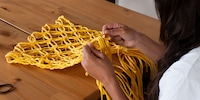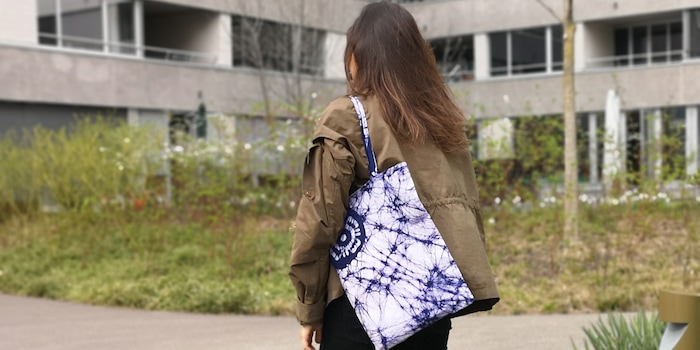
Background information
How to make your own macramé bag
by Stefanie Lechthaler

In the "DIY fashion for beginners" series, Anne and I show you how to sew fashion pieces or salvage clothes. In today's episode: How to sew a jute bag from old fabrics.
I've been a fan of cloth bags not just since the debate about plastic bags. No, I've always found the bags practical as they hardly take up any space in my handbag and I always have one to hand when I'm spontaneously shopping. My colleague and hobby tailor Anne also noticed my love of jute bags. That's why she suggested I sew one myself. "It's really easy. Really," she says with a wink.
We decide on a batik wrap skirt, which we repurpose. The bag can be made from old fabrics, curtains, sheets or tablecloths instead. There are no limits to your imagination. As I'm a big fan of linen at the moment, an old linen sheet will have to be used next.
What you need:
Depending on the size of the bag, cut out a large piece of fabric. Anne's cutting plate has the perfect dimensions (45 x 60 cm). That's why we use it as a pattern. As our batik skirt has different patterns, we look for a corner that we like. [[image:21138848,21138851]]
You will also need two strips of fabric of the same size for the handles. Once you have chosen the measurements, take double the width plus 2 cm for the seam allowance in the width and plus 4 cm seam allowance in the length. We opt for 66 cm long and 2 cm wide handles. Now fold the strip in half (pretty side to pretty side or right sides together) and sew them together lengthwise. [[image:21138852,21138853]]
After you have sewn the strip together with a straight stitch, you need to turn the inside of the fabric bead outwards. In my opinion, this part is the most tedious part of the whole process, as patience is not my strong point. A pencil will help you turn the fabric inside out. Tip: The wider the strap, the easier it is to turn inside out. [[image:21138854,21138856]]
Now fold the fabric of the bag in half lengthwise (right sides together) and mark the four places where you will attach the handles. In our case, we choose the distance (from the edge) minus 10 cm (seen from the open side) and minus 9 cm on the other side. The reason: as soon as we sew the open side together, we need a seam allowance of minus 1 cm. Next, mark the four points with a fan and use the sewing machine to sew the handles to the previously marked points.
Now the opening of the bag is finished. To do this, you need to fold over the edges using a so-called "fold over". To do this, fold the fabric over twice on the inside of the pocket so that the open edge is no longer visible. The whole thing is fastened again with güfeli and sewn together. [[image:21165225,21165205]]
Now you can sew the side and bottom of the bag together with the sewing machine. To keep the handle in position when carrying, fold it over again and secure it to the bag. [[image:21165198]]
As soon as you have stitched the straps with the sewing machine, the fabric bag is ready for use. Happy shopping. [[image:21138864,21138881]]
In our next episode Anne and I are pimping a pair of jeans. If you want more fashion DIYs on your radar, follow me by clicking the button on my author profile.
When I’m not exploring the depths of the sea as an open water diver, I enjoy plunging into the world of fashion. On the streets of Paris, Milan and New York is where I keep my eyes peeled for the latest trends. And I’ll show you how to take them from the catwalk to your everyday life.
Interesting facts about products, behind-the-scenes looks at manufacturers and deep-dives on interesting people.
Show all